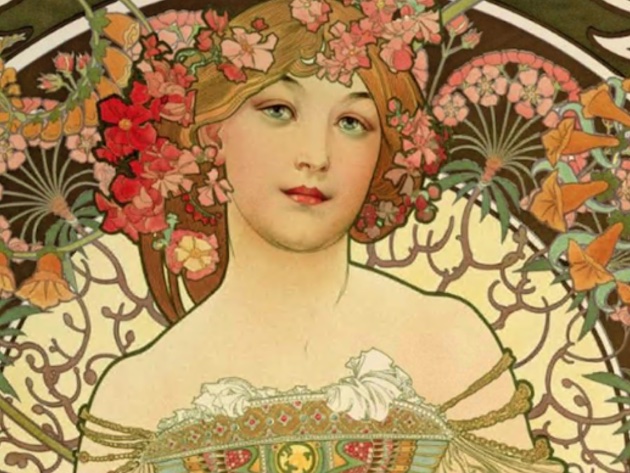
The exhibition dedicated to Alphonse Mucha, opening October 8th at Palazzo Bonaparte, plunges visitors in the Belle Époque, with all the beauty and charm characterizing that period. The exhibition in fact, represents an important opportunity to deepen one's understanding of Art Nouveau, the artistic movement that more than any other represented the historical period between 1871 and 1914. Alphonse Mucha (1860-1939) was one of the undisputed protagonists of this movement, thanks to his unmistakable style, making a fundamental contribution to the development and dissemination of a visual language that still fascinates and inspires today, from design to architecture.
Alphonse Mucha. Un trionfo di bellezza e seduzione (Alphonse Mucha. A triumph of beauty and seduction) features over 150 masterpieces by Mucha, retracing his entire career, presenting not only the most comprehensive and comprehensive exhibition ever held on this extraordinary artist, but also broadening the scope to include the great artists of all time who have explored the theme of beauty and female seduction. The guest of honor at the exhibition is Sandro Botticelli's Venus from the Musei Reali in Turin, a global emblem of timeless beauty; the painting is displayed alongside works by Giovanni Boldini, Cesare Saccaggi, ancient statues, Renaissance works, Art Nouveau furniture and objects, and much more.
And so, famous masterpieces and unpublished works alternate in a refined artistic tribute, recounting the evolution of a style that marked an era: sinuous lines and floral motifs dominate Mucha's advertising posters and decorative works, in a constant search for beauty and timeless elegance.
Born in 1860 in Ivancice, Moravia (now the Czech Republic), Alfons (Alphonse) Mucha came from a lower-middle-class family. Revealing his artistic vocation from a very young age, he entered the Academy of Arts in Munich in 1885, and before the age of 30, the artist left for Paris and enrolled at the Académie Julian. In Paris, Mucha lived in the Montmartre neighborhood, where he came into contact with numerous artists (Gauguin, among others); during this period, he also became interested in photography and created illustrations for the press. In 1894, he created his first poster for a play by Victorien Sardou entitled Gismonda, starring the famous actress Sarah Bernhardt. The refinement and beauty of the drawing convinced the “divine Sarah” to sign a six-year contract with Mucha (from 1895 to 1901), during which he designed posters, theatre sets, costumes and jewellery, occasionally also working as an artistic consultant. This marked the beginning of the Bohemian artist's great success, as he was entrusted with new and prestigious commissions: Mucha's advertising posters were used by major companies such as Nestlé, Moët & Chandon, JOB, Ruinart, Perfecta, and Waverley. In 1910, Mucha decided to devote the rest of his life to painting twenty large-scale paintings depicting a symbolic epic of the Slavic people since antiquity: from then on, all his energy will be devoted to the Slavic Epic. This work was officially handed over to the city of Prague in September 1928, but the artist continued to work on it until his death in Prague in 1939.
Under the patronage of the Embassy of the Czech Republic, the Lazio Region, the City of Rome – Department of Culture, and the Czech Centre at the Embassy of the Czech Republic, the exhibition is produced and organized by Arthemisia, in collaboration with the Mucha Foundation and the Royal Museums of Turin. Curators are Elizabeth Brooke and Annamaria Bava, with scientific direction by Francesca Villanti. The exhibition's main partner is the Fondazione Terzo Pilastro – Internazionale con Poema.
Photo: Alphonse Mucha, Reverie, 1896 – lithograph - 68 x 50 cm, Private collection
Informaciones
da lunedì a giovedì 9.00 - 19.30venerdì, sabato e domenica 9.00 - 21.00la biglietteria e l'ingresso chiudono un'ora prima
 Condividi
Condividi











































